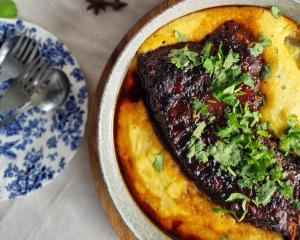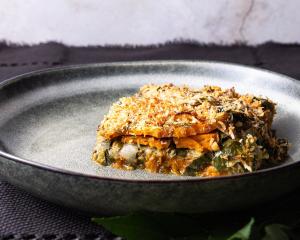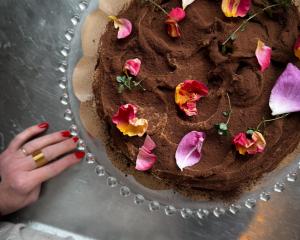
What could be better for Mother’s Day than a buttery, flaky croissant transformed into a glorious dessert or tasty tidbit to have with coffee. Pastry chef Kate Reid has the answer.
Ask any Melburnian and they will tell you the only thing they would ever queue for at 5 in the morning is a Lune croissant.
They are that good. Engineered perfection, people claim.
Maybe because they are the brainchild of an aerospace engineer who went on to be a Formula One engineer.
Pastry chef Kate Reid created legendary boulangerie Lune in Melbourne about 10 years ago and in her book Lune: Croissants All Day, All Night tells the story of how she came to create it as well as shares some of her favourite recipes.
The recipe for croissants in the book does not use a classic French method, nor is it how they make them at Lune, with its specialist equipment.
So it does take time and patience, she says.

It also takes some key ingredients as "not all croissants are created equal".
She advises using the best-quality flour you can buy with a high protein content. The same with butter, as quality is key, so preferably use cultured butter or clarified depending on the recipe.
Whole milk, large eggs and fresh yeast under three weeks old are also part of the secret.
On the equipment front, any keen baker has the tools — stand mixer, rolling pin, a ruler and a sharp knife.
For those not too keen on tackling the long involved croissant-making process, Reid has provided some of her favourite recipes using old croissants.
The book
Lune: Croissants All Day, All Night by Kate Reid, published by Hardie Grant Books, RRP $60 NZD, Photography credit: Pete Dillon
 Chocolate-dipped croissant biscotti
Chocolate-dipped croissant biscotti

Sometimes you don’t want a whole croissant with your coffee. Actually, I’m not crossing paths with any people who fit this description, so that’s potentially a misnomer, but for the purposes of this recipe, let’s pretend there are people out there who don’t want a whole croissant with their coffee.
In Italy, it’s common to have a coffee and a biscuit for breakfast, hence why I’ve named this recipe Croissant Biscotti. The texture of these thin, caramelised, double-baked slices of croissant are not dissimilar to biscotti, which is traditionally baked first as a large log of sweetened dough. The baked log is then sliced into individual thins which are laid flat and baked again, resulting in that famed crunchy, dry texture (perfect for dipping in your coffee).
If you happen to have any croissants left over, this is a sensational little sweet snack to have stored in the pantry. And if you’re like me, and you always want a whole croissant with your coffee, the best thing about these is that you don’t have to stop at one ...
Makes many!
Ingredients
6-day-old croissants, frozen
500g thickened cream
300g caster (superfine) sugar, plus extra for sprinkling
4 tsp sea salt flakes
Method
Preheat your oven to 150degC fan and line a baking tray with baking paper.
Remove one croissant at a time from the freezer to keep the pastry as frozen and solid as possible. Slice a croissant in half lengthways through the nose and then, using a mandoline or a very sharp serrated knife, cut very thin slices of croissant widthways across each half.
Place the cream, sugar and salt in a saucepan and warm over a low heat, whisking to dissolve the sugar and salt.
Working one slice at a time, carefully pick up the croissant thins and coat them in the warmed cream, drain off any excess and arrange the slices in one layer on the lined baking tray.
Sprinkle the cream-coated slices with a little extra sugar and place in the oven to bake until they have reached a medium to dark golden brown colour. This will take longer than you expect. Start with 30 minutes on the timer and check them at the 30-minute mark. They may need a little longer to become really caramelised.
Cool completely, then transfer to a container until you are ready to dip them in the chocolate.

1kg dark chocolate (70% cocoa solids)
10g cocoa butter
Set up a double boiler: bring 5cm of water to the boil in a medium saucepan then reduce heat to a simmer.
Place a heatproof metal bowl over the top of the saucepan, ensuring that the bottom of the bowl isn’t actually touching the water. Make sure the bowl fits snugly, because if any condensation coming from the simmering water makes its way into the bowl, it will ruin the tempering of the chocolate.
Place 750g of the chocolate in the bowl with the cocoa butter and melt, monitoring the temperature.
Once it reaches 50degC fan, carefully remove the bowl from the saucepan and gradually add the remaining 250g of chocolate, stirring constantly with a clean, dry spatula and continuing to monitor the temperature. Adding the 250g of chocolate will have reduced the temperature of the melted chocolate.
Reduce the temperature of the chocolate to 28degC, then place the bowl of melted chocolate briefly back over the saucepan, continually stirring, and bring the chocolate up to 32degC.
Your chocolate is now perfectly tempered and ready to use immediately.
Finishing
Line a couple of trays with baking paper.
Take a cooled slice of croissant biscotti and dip one end into the melted tempered chocolate.
Twirl the piece of croissant around to allow any excess chocolate to drip off, then lay the slice of croissant on to one of the trays.
Allow to set completely.
If you have tempered your chocolate correctly, the surface should be shiny, and it will snap when you break it or bite into it.
Repeat with the remaining slices.
Store in an airtight container in single layers, separated by baking paper.
Chef’s note
You need to work very quickly to slice the croissants, as they don’t take long to thaw out, and keeping them as solid as possible is the key to cutting even, thin slices.
 Carrot cake twice baked
Carrot cake twice baked

Carrot cake is my favourite cake on the planet. That is all.
No, jokes. I do have more to say about carrot cake. Not all carrot cakes were created equal. I’m pretty opinionated on my do’s and don’ts with carrot cake.
Do include walnuts (although they must be chopped; cutting a slice of carrot cake with whole walnuts in it is destined for failure). Pecans work too, but I’m a walnut girl at heart.
Do not include raisins (or dried fruit of any form, for that matter). It’s all about the cream cheese icing. I’ve met one person in my life who prefers carrot cake without cream cheese icing. We’re not friends anymore.
Yields 6
Ingredients
Six-day-old croissants
Spiced brown sugar syrup
Carrot and walnut frangipane
Carrot cake crumble
Icing (powdered) sugar, for dusting
Cream cheese icing
Dehydrating the carrots
500g carrots
The frangipane calls for 60g of dried carrot and 25g of the crumble. In order to end up with 85g of dehydrated carrot, you will need to start with about 500g of raw carrot.
Preheat your oven to 70degC fan (or as low as it will go) and line a baking tray with baking paper. You can also use a dehydrator if you have one.
Top and tail the carrots, peel, then grate finely. Evenly and thinly spread out the grated carrot, so there is good airflow around the grated carrot. Place the tray of grated carrot in the oven for several hours, until it is dry, but hasn’t coloured; you’re simply wanting to draw the moisture out, not cook it.
Carrot puree
100g carrot pieces, peeled and roughly chopped
Cook the chopped carrot in a small saucepan of boiling water until it is soft (you should easily be able to stick a fork in it). Once the carrot is soft, drain it well, then blend until smooth.
Allow to cool to room temperature, then use immediately or store in an airtight container in the fridge until required.
Carrot and walnut frangipane
200g butter, at room temperature
100g caster (superfine) sugar
100g brown sugar
2 eggs
100g natural almond meal
100g walnut meal
¼ teaspoon ground cinnamon
¼ teaspoon mixed spice
80g carrot puree
60g dried grated carrot
Beat the butter and sugar in a stand mixer fitted with a flat beater until pale and fluffy. Add the eggs one at a time, continuing to beat and waiting until each one is incorporated fully before adding the next. Scrape down the bowl after the incorporation of the first egg.
Add the natural almond meal, walnut meal and the spices and combine with the mixer on low speed.
Finally, add the carrot puree and dried grated carrot, and with the mixer still on low speed, combine all the ingredients.
Scrape the bowl down well and give it a final mix by hand to ensure all the ingredients are well incorporated.
Transfer the frangipane into a piping bag fitted with a size 11-star nozzle.
Carrot cake crumble
100g brown sugar
¼tsp ground cinnamon
¼tsp mixed spice
60g plain (all-purpose) flour
40g natural almond meal
40g walnut meal
25g dried grated carrot
80g butter, softened
Add all the dry ingredients to the bowl of a stand mixer fitted with a flat beater. Before attaching the bowl to the mixer, using a hand whisk combine the dry ingredients so they are well incorporated.
Now add the softened butter, then mix on low speed until the ingredients start to bind together, forming a chunky crumble consistency. Youre looking for small pebble-sized pieces of crumble.
Spiced brown sugar syrup
500g water
150g caster (superfine) sugar
100g brown sugar
1 tsp vanilla extract
1 cinnamon stick
Pinch of mixed spice
Pinch of nutmeg
Place all the ingredients in a small saucepan and stir over a medium heat until the sugar has dissolved and the cinnamon has infused the syrup, then bring the syrup to the boil. Once boiling, remove from the heat.
Cream cheese icing
250g cream cheese
25g butter, softened
25g icing (powdered) sugar, sifted
1 tsp lemon juice
Place the cream cheese in the bowl of a stand mixer fitted with the flat beater and soften the cream cheese by beating on medium-high speed for a minute or so.
Add the butter and beat until smooth and homogenous. Finally, add the icing (powdered) sugar and lemon juice and beat until everything is fully incorporated. Transfer to a piping bag fitted with a size 11 star nozzle.
If you have prepared this in advance, let it sit at room temperature for an hour or two before using.
Assembling, baking and finishing
Preheat your oven to 180degC fan (350degF) and line a large baking tray with baking paper.
Using a large serrated knife, cut the croissants in half. Brush the cut side of both halves of each croissant generously with the spiced brown sugar syrup.
Pipe a generous wiggle of carrot and walnut frangipane on the bottom half of each croissant.
Replace the top half of each croissant, cupping your hand and gently securing each top.
Finish off each croissant by piping a seam of carrot and walnut frangipane across the top, then press chunks of carrot cake crumble into the seam of frangipane, all the way along the top of the croissant.
Place the prepared croissants on the lined baking tray and bake for 20-25 minutes, until the frangipane inside is set.
Towards the end of the baking time, check to see if the frangipane is baked by carefully lifting the lid of the croissant.
If the frangipane still looks like cake batter, it is not yet ready. Bake for a few more minutes and check again.
Remove from the oven and allow to cool to room temperature.
Once cooled completely, dust with icing sugar.
Finally, pipe five rosettes of cream cheese icing along the top of each croissant.
It is important that this is done when the croissant is completely cool, otherwise the icing will melt.
Enjoy!
Chef’s note:
Whoever thought carrot cake would pair so shockingly well with croissant? Your first bite will confirm it really does. Your second bite might even convince you from this moment on, carrot cake must always be eaten with croissant. I mean, if you’re skating on thin ice, you may as well tap dance...













